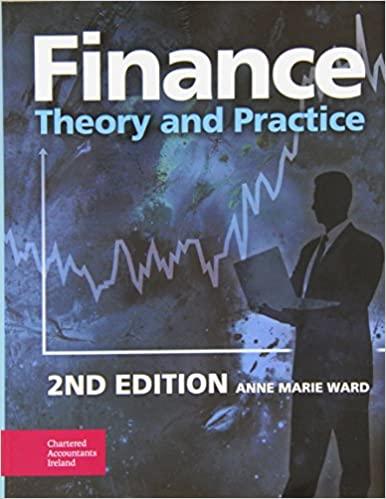Question
QUESTION 1 Risk in cash flow estimating for capital budgeting can be defined as: a. the chance that a cash flow will turn out to
QUESTION 1
-
Risk in cash flow estimating for capital budgeting can be defined as:
a. the chance that a cash flow will turn out to be worse than the estimate.
b. the chance that a cash flow will turn out to be different than the estimate, either better or worse.
c. the chance that the cash flows that turn out to be more favorable than the estimate won't totally offset the cash flows that turn out to be worse than the estimate.
d. the chance that the NPV and/or IRR will turn out to be worse than the estimate.
e. All of the above describe the risk in cash flow estimating.
QUESTION 2
-
A firm has current assets of $10,000 and current liabilities of $6,000. Cash and marketable securities total $4,000, the balance in accounts receivable is $2,000, and the book value of inventory is $4,000. The firm's net working capital is:
a. $2,000.
b. $4,000.
c. $6,000.
d. $9,000.
e. None of the above
QUESTION 3
-
Project A generates $5,000.00 in revenue two years from today and costs $4,000.00. Project B generates $4,000.00 (50% probability) or $6,000.00 (50% probability) one year from today and costs $4,500.00. Assuming a discount rate of 12% for both projects, which project does a risk averse manager prefer?
a. Project A
b. Project B
c. Neither project
d. Cannot be determined
QUESTION 4
-
Determine the (after-tax) component cost of a $50 million debt issue that the Mattingly Corporation is planning to place with a large insurance company. Assume the company is subject to a 40% tax rate. This long-term debt issue will yield 12% to the insurance company.
a. 4.8%
b. 7.2%
c. 12.0%
d. None of the above
QUESTION 5
-
A firm has EBIT of $300,000 and depreciation expense of $12,000. Fixed charges total $44,000. Interest expense totals $7,000. What is the firm's cash coverage ratio?
3.76 times
7.09 times
7.25 times
4.91 times
QUESTION 6
-
Your company is expected to earn $4.0 million in net income next year of which it will pay out 40% in dividends. If equity represents 50% of your capital, what is the breakpoint on the MCC where new stock will have to be issued?
a. $2.4 million
b. $4.8 million
c. $4.0 million
d. $3.2 million
e. $8.0 million
QUESTION 7
-
Morrison Moverss optimal capital structure calls for financing seventy percent of new assets with equity. Assuming that Morrison Movers has net income of $5 million, how much can be paid out in the form of a dividend and still have sufficient funds to cover a $6 million capital budget?
a. $ 800,000
b. $0, it needs all of the funds for expansion.
c. $4,200,000
d. $5,000,000
QUESTION 8
-
A firm that's subject to a 40 percent tax rate has debt of $60M, equity of $140M, and no preferred stock. What is the firm's cost of capital (WACC) if its pretax cost of new debt is 12 percent, the pretax cost of its old debt is 8%, and its cost of equity is 14.5 percent?
a. 13.75%
b. 11.59%
c. 12.31%
d. None of the above
QUESTION 9
-
A firm's correctly computed capital structure is 30% debt, 20% preferred stock, and 50% equity. If retained earnings of $1 million are expected, how much capital will have been raised when retained earnings are exhausted and new common equity must be issued?
a. $1,428,571
b. $2,000,000
c. $3,333,333
d. $1,000,000
QUESTION 10
-
A firm pays its bondholders a 12% return. Its cost of retained earnings may be estimated by:
a. adding one to three percentage points to the 12% pretax cost of debt.
b. adding three to five percentage points to the 12% pretax cost of debt.
c. multiplying the firm's beta by three to five percentage points and adding it to the 12% pretax cost of debt.
d. None of the above
Step by Step Solution
There are 3 Steps involved in it
Step: 1

Get Instant Access to Expert-Tailored Solutions
See step-by-step solutions with expert insights and AI powered tools for academic success
Step: 2

Step: 3

Ace Your Homework with AI
Get the answers you need in no time with our AI-driven, step-by-step assistance
Get Started


